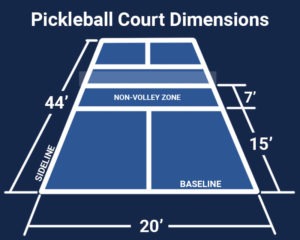Pickleball Court Construction-- Professional Setup for Your Dream Court
Pickleball Court Construction-- Professional Setup for Your Dream Court
Blog Article
Sustainable Practices in Pickleball Court Building And Construction You Ought To Know
As the appeal of pickleball proceeds to increase, so as well does the demand for lasting techniques in court construction. The effect of these practices extends much beyond the court itself.
Picking Eco-Friendly Materials
Selecting eco-friendly products is a crucial action in the building and construction of lasting pickleball courts. The selection of sustainable products not just lessens ecological impact but likewise improves the durability and performance of the court. Secret products consist of reused rubber for the surface area, which supplies superb sturdiness and shock absorption while diverting waste from land fills.
Additionally, making use of locally sourced materials lowers transportation discharges and supports local economic situations. Pickleball court construction. As an example, using native woods for fence and seating can offer a sustainable aesthetic while making sure strength versus the elements.
Including absorptive materials for court foundations can additionally add to sustainability by enabling natural water drainage and decreasing drainage. These selections not only safeguard regional communities but likewise advertise healthier play settings.
Effective Water Drainage Solutions
While the option of environment-friendly materials is vital, executing efficient drain services is equally important for keeping sustainable pickleball courts. Correct drainage not just protects the court surface from water damages but likewise decreases disintegration and drainage, promoting environmental stability.
Effective drainage systems can include permeable paving, which enables water to infiltrate the ground instead than merging on the surface. This reduces the likelihood of standing water, which can lead to mold and other upkeep problems. Furthermore, integrating strategically positioned drainage networks and swales can route excess water far from the court area, ensuring a dry playing surface area and protecting against dirt disintegration.
Using native greenery in the landscape design around the courts can additionally improve drain by absorbing excess water and decreasing runoff. These plants call for less watering and promote biodiversity, aligning with lasting practices.
Additionally, it is essential to on a regular basis maintain the drainage system to ensure its long-lasting performance. This includes clearing debris and monitoring for obstructions. By prioritizing reliable drain remedies, pickleball court builders can dramatically add to the sustainability and longevity of the facility, inevitably profiting both players and the environment.
Energy-Efficient Lighting Options
As the demand for pickleball remains to expand, incorporating energy-efficient illumination options into court design has ended up being progressively essential for sustainability. Traditional illumination systems commonly eat extreme power, adding to greater operational prices and ecological impact. As a result, embracing contemporary, a knockout post energy-efficient modern technologies is essential for both brand-new building and constructions and renovations.
LED (Light Emitting Diode) illumination attracts attention as a top option due to its longevity and energy cost savings (Pickleball court construction). Compared to standard illumination, LEDs make use of roughly 75% less power and can last as much as 25 times longer, considerably reducing maintenance expenses. Furthermore, the directional nature of LED illumination decreases light air pollution, making certain that illumination is concentrated on the court instead than surrounding locations.

Sustainable Surface Area Alternatives
Exploring sustainable surface alternatives for pickleball courts has gained traction amongst players and home builders alike. The emphasis on environmentally friendly products not just straightens with the expanding ecological awareness but additionally boosts the efficiency and longevity of the courts.
One popular choice is making use of recycled rubber, which can be sourced from made use of tires. This product provides outstanding shock absorption, decreasing the threat of injuries for gamers while promoting sustainability. Furthermore, modular tiles made from recycled plastics offer one more feasible choice. These tiles are easy to change and set up, and their flexibility permits numerous court configurations.
All-natural turf courts are also emerging as a lasting selection, promoting biodiversity and lowering the heat island impact. They call for regular upkeep and water, which might not straighten with all sustainability goals.

Water Preservation Techniques

One more effective strategy includes the installment of rain harvesting this page systems. These systems accumulate and save rain for usage in preserving court surface areas and landscape design. This method not only saves safe why not check here and clean water yet additionally minimizes reliance on local resources.
In addition, utilizing drought-resistant landscaping around the courts is necessary. Native plants need less water and are much better adjusted to neighborhood climate conditions, thus decreasing overall water usage. Additionally, using reliable watering systems, such as drip irrigation, makes certain that water is supplied directly to plant origins, lessening evaporation and waste.
Final Thought
Incorporating sustainable methods in pickleball court construction considerably contributes to ecological preservation and resource performance. By focusing on these practices, the construction of pickleball courts can line up with wider environmental objectives while advertising durability and functionality within areas.
As the popularity of pickleball proceeds to increase, so also does the demand for lasting techniques in court building.Choosing environment-friendly products is an important step in the construction of lasting pickleball courts. By prioritizing energy-efficient illumination choices, pickleball court builders can add to a more sustainable future while meeting the requirements of players and stakeholders alike.Incorporating lasting surface area alternatives not just boosts the performance of pickleball courts yet also paves the method for carrying out efficient water conservation strategies.Integrating sustainable methods in pickleball court building dramatically contributes to environmental conservation and source effectiveness.
Report this page